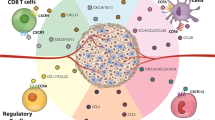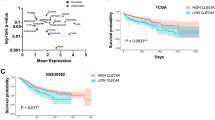Abstract
Chemokines and their receptors are essential for leukocyte trafficking, and also implicated in cancer metastasis to specific organs. We have recently demonstrated that CXCR3 plays a critical role in metastasis of mouse melanoma cells to lymph nodes. Here, we show that some human colon cancer cell lines express CXCR3 constitutively. We constructed cells that expressed CXCR3 cDNA (‘DLD-1-CXCR3’), and compared with nonexpressing controls by rectal transplantation in nude mice. Although both cell lines disseminated to lymph nodes at similar frequencies at 2 weeks, DLD-1-CXCR3 expanded more rapidly than the control in 4 weeks. In 6 weeks, 59% of mice inoculated with DLD1-CXCR3 showed macroscopic metastasis in para-aortic lymph nodes, whereas only 14% of those with the control (P<0.05). In contrast, metastasis to the liver or lung was rare, and unaffected by CXCR3 expression. In clinical colon cancer samples, we found expression of CXCR3 in 34% cases, most of which had lymph node metastasis. Importantly, patients with CXCR3-positive cancer showed significantly poorer prognosis than those without CXCR3, or those expressing CXCR4 or CCR7. These results indicate that activation of CXCR3 with its ligands stimulates colon cancer metastasis preferentially to the draining lymph nodes with poorer prognosis.
This is a preview of subscription content, access via your institution
Access options
Subscribe to this journal
Receive 50 print issues and online access
$259.00 per year
only $5.18 per issue
Buy this article
- Purchase on Springer Link
- Instant access to full article PDF
Prices may be subject to local taxes which are calculated during checkout





Similar content being viewed by others
Accession codes
References
Amichay D, Gazzinelli RT, Karupiah G, Moench TR, Sher A, Farber JM . (1996). Genes for chemokine MuMig and Crg-2 are induced in protozoan and viral infections in response to IFN-γ with patterns of tissue expression that suggest nonredundant roles in vivo. J Immunol 157: 4511–4520.
Balkwill F . (2004). Cacner and the chemokine network. Nat Rev Cancer 4: 540–550.
Bao S, Ouyang G, Bai X, Huang Z, Ma C, Liu M et al. (2004). Periostin potently promotes metastatic growth of colon cancer by augmenting cell survival via Akt/PKB pathway. Cancer Cell 5: 329–339.
Cella M, Jarrossay D, Facchetti F, Alebardi O, Nakajima H, Lanzavecchia A et al. (1999). Plasmacytoid monocytes migrate to inflamed lymph nodes and produce large amounts of type I interferon. Nat Med 5: 919–923.
Chambers AF, Groom AC, MacDonald IC . (2002). Dissemination and growth of cancer cells in metastatic sites. Nat Rev Cancer 2: 563–572.
Cyster JG . (1999). Chemokines and cell migration in secondary lymphoid organs. Science 286: 2098–2101.
Dijkstra IM, Hulshof S, van der Valk P, Boddeke HW, Biber K . (2004). Activity of human adult microglia in response to CC chemokine ligand 21. J Immunol 172: 2744–2747.
Dwinell MB, Lugering N, Eckmann L, Kagnoff MF . (2001). Regulated production of interferon-inducible T-cell chemoattractants by human intestinal epithelial cells. Gastroenterology 120: 49–59.
Fidler IJ, Kripke ML . (1977). Metastasis results from preexisting variant cells within a malignant tumor. Science 197: 893–895.
Flatmark K, Maelandzmo GM, Martinsen M, Rasmussen H, Fodstad O . (2004). Twelve colorectal cancer cell lines exhibit highly variable growth and metastatic capacities in an orthotopic model in nude mice. Eur J Cancer 40: 1593–1598.
Fleming JB, Cooper JS, Henson DE, Hutter RV, Kennedy BJ, Murphy GP et al. (1997). AJCC colon and rectum. In: Greene FL et al. (eds). AJCC Cancer Staging Manual. Lippincott-Raven Publishers: Philadelphia, PA, pp 83–90.
Gattass CR, King LB, Luster AD, Ashwell JD . (1994). Constitutive expression of interferon γ-inducible protein 10 in lymphoid organs and inducible expression in T cells and thymocytes. J Exp Med 179: 1373–1378.
Janatpour MJ, Hudak S, Sathe M, Sedgwick JD, McEvoy LM . (2001). Tumor necrosis factor-dependent segmental control of MIG expression by high endothelial venules in inflamed lymph nodes regulates monocyte recruitment. J Exp Med 193: 1375–1384.
Jordan NJ, Kolios G, Abbot SE, Sinai MA, Thompson DA, Petraki K et al. (1999). Expression of functional CXCR4 chemokine receptors on human colonic epithelial cells. J Clin Invest 104: 1061–1069.
Kang Y, Siegel PM, Shu W, Drobnjak M, Kakonen SM, Cordon-Cardo C et al. (2003). A multigenic program mediating breast cancer metastasis to bone. Cancer Cell 3: 537–549.
Kashtan H, Rabau M, Mullen JBM, Wong AHC, Roder JC, Shpitz B et al. (1992). Intra-rectal injection of tumor cells: a novel animal model of rectal cancer. Surg Oncol 1: 251–256.
Kawada K, Sonoshita M, Sakashita H, Takabayashi A, Yamaoka Y, Manabe T et al. (2004). Pivotal role of CXCR3 in melanoma cell metastasis to lymph nodes. Cancer Res 64: 4010–4017.
Kim J, Takeuchi H, Lam ST, Turner RR, Wang HJ, Kuo C et al. (2005). Chemokine receptor CXCR4 expression in colorectal cancer patients increases the risk for recurrence and for poor survival. J Clin Oncol 23: 2744–2753.
Luther SA, Tang HL, Hynman PL, Farr AG, Cyster JG . (2000). Coexpression of the chemokines ELC and SLC by T zone stromal cells and deletion of the ELC gene in the plt/plt mouse. Proc Natl Acad Sci USA 97: 12694–12699.
Mancardi S, Vecile E, Dusetti N, Carvo E, Stanta G, Burrone OR et al. (2003). Evidence of CXC, CC and C chemokine production by lymphatic endothelial cells. Immunology 108: 523–530.
Martin-Fontecha A, Thomsen LL, Brett S, Gerard C, Lipp M, Lanzavecchia A et al. (2004). Induced recruitment of NK cells to lymph nodes provides IFN-γ for TH1 priming. Nat Immunol 5: 1260–1265.
Mashino K, Sadanaga N, Yamaguchi H, Tanaka F, Ohta M, Shibuta K et al. (2002). Expression of chemokine receptor CCR7 is associated with lymph node metastasis of gastric carcinoma. Cancer Res 62: 2937–2941.
Müller A, Homey B, Soto H, Ge N, Catron D, Buchanan ME et al. (2001). Involvement of chemokine receptors in breast cancer metastasis. Nature 410: 50–56.
Ninomiya I, Terada I, Yoshizumi T, Takino T, Nagai N, Morita A et al. (2004). Anti-metastatic effect of capecitabine on human colon cancer xenografts in nude mouse rectum. Int J Cancer 112: 135–142.
Ochsenbein AF, Sierro S, Odermatt B, Pericin M, Karrer U, Hermans J et al. (2001). Roles of tumour localization, second signals and cross priming in cytotoxic T-cell induction. Nature 411: 1058–1064.
Palframan RT, Jung S, Cheng G, Weninger W, Luo Y, Dorf M et al. (2001). Inflammatory chemokine transport and presentation in HEV: a remote control mechanism for monocyte recruitment to lymph nodes in inflamed tissues. J Exp Med 194: 1361–1373.
Petrova TJ, Makinen T, Makela TP, Saarela J, Virtanen I, Ferrell RE et al. (2002). Lymphatic endothelial reprogramming of vascular endothelial cells by the Prox-1 homeobox transcription factor. EMBO J 21: 4593–4599.
Poggi A, Carosio R, Fenoglio D, Brenci S, Murdaca G, Setti M et al. (2004). Migration of Vδ1 and Vδ2T cells in response to CXCR3 and CXCR4 ligands in healthy donors and HIV-1-infected patients: competition by HIV-1 Tat. Blood 103: 2205–2213.
Robledo MM, Barolom RA, Longo N, Rodríguez-Frade JM, Mellado M, Longo I et al. (2001). Expression of functional chemokine receptors CXCR3 and CXCR4 on human melanoma cells. J Biol Chem 276: 45098–45105.
Saeki H, Moore AM, Brown MJ, Hwang ST . (1999). Cutting edge: secondary lymphoid-tissue chemokine (SLC) and CC chemokine receptor 7 (CCR7) participate in the emigration pathway of mature dendritic cells from the skin to regional lymph nodes. J Immunol 162: 2472–2475.
Schimanski CC, Schwald S, Simiantonaki N, Jayasinghe C, Gonner U, Wilsberg V et al. (2005). Effect of chemokine receptors CXCR4 and CCR7 on the metastatic behavior of human colorectal cancer. Clin Cancer Res 11: 1743–1750.
Soejima K, Rollins BJ . (2001). A functional IFN-γ-inducible protein-10/CXCL10-specific receptor expressed by epthelial and endothelial cells that is neither CXCR3 nor clycosaminoglycan. J Immunol 167: 6576–6582.
Soto H, Wang W, Strieter RM, Copeland NG, Gilbert DJ, Jenkins NA et al. (1998). The CC chemokine 6Ckine binds the CXC chemokine receptor CXCR3. Proc Natl Acad Sci USA 95: 8205–8210.
Tannenbaum CS, Tubbs R, Armstrong D, Finke JH, Bukowski RM, Hamilton TA . (1998). The CXC chemokine IP-10 and Mig are necessary for IL-12-mediated regression of the mouse RENCA tumor. J Immunol 161: 927–932.
Trentin L, Agostini C, Facco M, Piazza F, Perin A, Siviero M et al. (1999). The chemokine receptor CXCR3 is expressed on malignant B cells and mediates chemotaxis. J Clin Invest 104: 115–121.
Tsutsumi S, Kuwano H, Morinaga N, Shimura T, Asao T . (2001). Animal model of para-aortic lymph node metastasis. Cancer Lett 169: 77–85.
Vicari AP, Ait-Yahita S, Chemin K, Mueller A, Zlotnick A, Caux C . (2000). Antitumor effects of the mouse chemokine 6Ckine/SLC through angiostatic and immunological mechanism. J Immunol 165: 1992–2000.
Vlahakis SR, Villasis-Keever A, Gomez T, Venegas M, Vlahakis N, Paya CV . (2002). G protein-coupled chemokine receptors induce both survival and apoptotic signaling pathways. J Immunol 169: 5546–5554.
von Andrian UH, Mempel TR . (2003). Homing and cellular traffic in lymph nodes. Nat Rev Immunol 3: 867–878.
Walser TC, Rifat S, Ma X, Kundu N, Ward C, Goloubeva O et al. (2006). Antagonism of CXCR3 inhibits lung metastasis in a murine model of metastatic breast cancer. Cancer Res 66: 7701–7707.
Wiley HE, Gonzalez EB, Maki W, Wu M, Hwang ST . (2001). Expression of CC chemokine receptor-7 and regional lymph node metastasis of B16 murine melanoma. J Natl Cancer Inst 93: 1638–1643.
Yoneyama H, Narumi S, Zhang Y, Murai M, Baggiolini M, Lanzavecchia A et al. (2002). Pivotal role of dendritic cell-derived CXCL10 in the retention of T helper cell 1 lymphocytes in secondary lymph nodes. J Exp Med 195: 1257–1266.
Zeelenberg IS, Ruuls-Van Stalle L, Roos E . (2003). The chemokine receptor CXCR4 is required for outgrowth of colon carcinoma micrometastasis. Cancer Res 62: 3833–3839.
Zhang R, Zhang H, Zhu W, Pardee AB, Coffey Jr RJ, Liang P et al. (1997). Mob-1, a Ras target gene, is overexpressed in colorectal cancer. Oncogene 14: 1607–1610.
Acknowledgements
We thank Masahiro Aoki and Takanori Kitamura for fruitful discussion and Hiromi Kikuchi for technical assistance. We also thank Drs T Kitamura and M Onishi (University of Tokyo) for retroviral vector pMX. This work was supported by grants from the Ministry of Education, Culture, Sports, Science and Technology of Japan.
Author information
Authors and Affiliations
Corresponding author
Additional information
Supplementary Information accompanies the paper on the Oncogene website (http://www.nature.com/onc).
Rights and permissions
About this article
Cite this article
Kawada, K., Hosogi, H., Sonoshita, M. et al. Chemokine receptor CXCR3 promotes colon cancer metastasis to lymph nodes. Oncogene 26, 4679–4688 (2007). https://doi.org/10.1038/sj.onc.1210267
Received:
Revised:
Accepted:
Published:
Issue Date:
DOI: https://doi.org/10.1038/sj.onc.1210267
Keywords
This article is cited by
-
Chemoproteomic mapping of the glycolytic targetome in cancer cells
Nature Chemical Biology (2023)
-
Targeting CXCL9/10/11–CXCR3 axis: an important component of tumor-promoting and antitumor immunity
Clinical and Translational Oncology (2023)
-
Gene expression study of host-human T-cell leukaemia virus type 1 (HTLV-1) interactions: adult T-cell leukaemia/lymphoma (ATLL)
Molecular Biology Reports (2023)
-
Chemokines orchestrate tumor cells and the microenvironment to achieve metastatic heterogeneity
Cancer and Metastasis Reviews (2021)
-
CXCL-10: a new candidate for melanoma therapy?
Cellular Oncology (2020)



